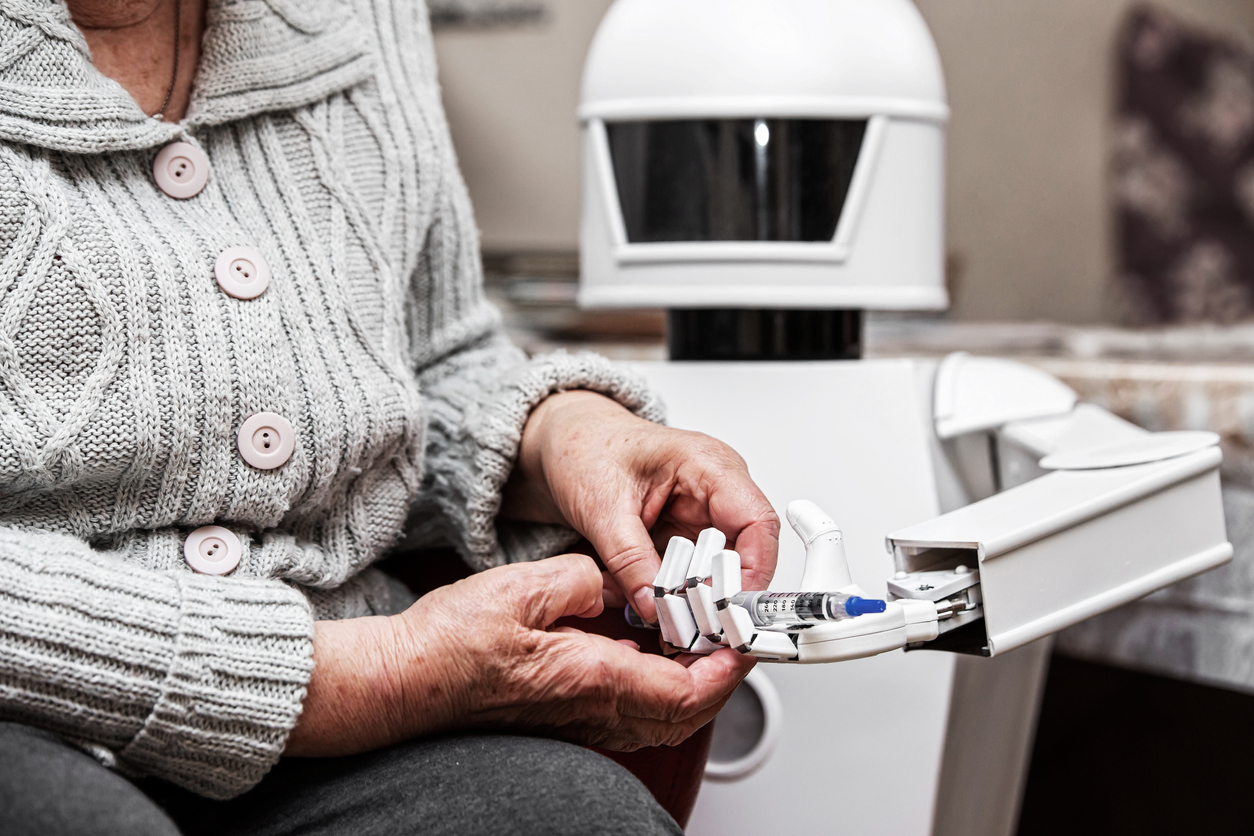Leveraging Nursing Technology: Tools for Nurse Leaders
Written by:
University of Tulsa
• Jan 18, 2024

Leveraging Nursing Technology: Tools for Nurse Leaders
Technological innovation causes evolution. Its progression places the health care industry in a state of constant flux, in which new technology-driven concepts have the potential to improve care delivery. This can theoretically make it easier for health care facilities to achieve their primary goal of providing high-quality care that may improve patient outcomes.
Such innovations have a direct impact on the nursing field, in which emerging forms of technology have influenced changes in several aspects of nursing, including direct impacts on the patient-provider relationship. The volume of nursing technology available can offer nurse leaders terrific options to develop strategies that improve training, care, and administration within their nursing program.
However, using these options effectively requires knowing how these different types of technology can impact care delivery. This knowledge can allow nurse leaders to determine whether using the technology makes sense for their program and allow them to integrate various types of technology into their facility with greater efficiency and effectiveness.
The Importance of Nursing Technology Advancements
Technology’s ability to radically improve care delivery has been proven. Devices that were once breakthroughs are now examples of what tools nurses use regularly. This evolution from new to normal highlights how they’ve changed the nursing field, and this can provide nurse leaders with reminders of how implementing the right forms of technology can lead to transformative care strategies.
Nursing Technology Examples From History
Several innovative devices and machines are examples of nursing technology that have improved care delivery. The sphygmomanometer — the automatic blood pressure cuff — has allowed nurses to measure blood pressure more accurately. Defibrillators and crash carts — Anita Dorr, an emergency room nurse, invented the crash cart — have revolutionized nursing in emergency care settings. The use of radiology in devices such as X-rays, ultrasounds, and CT scans has allowed nurses and other health care professionals to gain insight into a person’s health by looking inside the body without incisions.
Nursing technology advancements continue in the 21st century, but they do so in a way that can go beyond improved diagnosis. Complex concepts such as the Internet of Things (IoT) and artificial intelligence (AI) impact the administrative and operational sides of the nursing profession by streamlining processes and simplifying basic but essential tasks. Nurse leaders who use these technologies properly can improve nursing efficiency.
The efficiency that nursing technology can collectively deliver makes it possible for facilities to promote high-level care delivery philosophies like evidence-based practice more effectively. Using technological innovations in nursing to handle routine tasks can free up a nurse’s time. This extra time can be spent on meaningful patient interaction or make it easier to conduct research in nursing — elements that can potentially even lead to further innovation.
The blend of diagnostic and administrative breakthroughs in the nursing field demonstrates why nurse leaders need to seek out ways to integrate technological innovations into their health care strategies. Each advancement that occurs can have a positive impact on the patient in meaningful ways, from improved care to better access to their own health information. Ideally, this can lead to happier, healthier patients; this is what a health care facility would like to see.
Types of Nursing Technology
Contemporary nursing technology comes in many forms, and each can improve a facility’s care delivery system in different ways. While some of this technology has been somewhat established in the health care field, other types of innovation emerging in the profession may appear to be the stuff of science fiction. However, nurse leaders need to bear in mind that equipment like sonograms and X-rays once appeared that way. As such, the types of nursing technology below should be viewed as intriguing items that can lead to a better future for patient care delivery.
Electronic Health Records
Electronic health records (EHRs) are digital records that combine comprehensive health data with patient information. These records are stored digitally, eliminating the need for a facility to set aside large amounts of storage space for physical copies. EHRs also use cloud technology to store the records, allowing medical providers from different facilities equal access to patient records.
This can streamline patient care spread over multiple facilities. For example, a nurse practitioner in one facility can just pull up the patient record instead of having to contact another facility and request the record. Such ease of access among nurses and health care professionals greatly improves the opportunity for a patient to receive optimal care in complex situations.
Telehealth
Telehealth allows nurses and physicians to administer diagnostic patient care via videoconferencing. This is convenient for patients who may not have the time or the means to make an in-person health visit. Because this mode of health care is remote, it can help reduce the potential for canceled appointments. It can also reduce clinical visits, as the conditions assessed in a telehealth situation can be used to determine whether a patient needs to go to the doctor’s office for further treatment.
Virtual Reality
Once thought to be a tool for video games, virtual reality (VR) is an increasingly serious part of the nursing technology landscape. The main reason for its popularity is the numerous applications it offers nurse leaders. Health care facilities are boosting the use of VR tools to train new nurses and clinicians on treatment techniques, including surgical procedures. They’re also using it to create artificial environments for patients to rehabilitate themselves or to measure and manage their pain. In the latter scenarios, the VR devices can present key data about a patient’s progress, which can be used to adjust care delivery strategies.
The rise of VR in health care correlates to many operational elements. It’s cost-effective in the long run as it offers a facility to engage in repeatable clinical training sessions without having to replace materials needed for such sessions. It also allows nurses to collect patient data to help build more targeted paths that optimize the chances of a patient making a full recovery. In surgical settings, it can allow surgeons to practice delicate, complex surgeries safely, allowing them to master tricky techniques before tackling the real procedure.
Assistive Robotics
Robots aren’t coming to take jobs away from nurses. In fact, they’re improving a nurse’s ability to do their job and achieve their patient care goals. Assistive robots — from the 4-foot-tall humanoid robot Moxi (not to be confused with Moxie, a companion robot) to the autonomous mobile robot TUG — can handle a host of tasks considered routine and mundane yet fundamental for optimized care. These tasks include the following:
- Bringing food and medications to patients
- Delivering laboratory samples
- Retrieving medical supplies
- Disinfecting hospital spaces
- Providing companionship for patients
Social companion robots, a unique branch of assistive robotics, make the last task on the list possible. Robots such as Pepper, Stevie, and Jibo, come in various sizes and animallike or humanlike shapes and are programmed to have interactions with patients. Some of them use equipment such as microphones, touch sensors, and cameras to further enhance their ability to interact.
As robotics technology in health care continues to evolve, a robot’s abilities in health care will also expand. Transferring older adult patients from their beds, dressing patients who are unable to dress themselves, drawing blood, and expanding surgical assistance are all possibilities.
A robot handles tasks that would otherwise occupy a nurse’s time, giving nurses extra time to focus on the more complex elements behind optimized care delivery. A robot’s work can also reduce a nurse’s workload, which is vital given the ongoing nursing shortage. Other benefits of assistive robots in nursing include reducing a nurse’s physical strain, improving workplace efficiency, and enhancing safety.
Artificial Intelligence
Increasingly powerful AI programs can help nurses glean actionable insight from complex data sets. Their ability to quickly analyze data and yield supportive insights can allow nurses to make more accurate decisions on patient care strategies. The ways that AI can benefit a health clinic include the following:
- Determining whether a patient is at higher risk of certain diseases
- Predicting patient outcomes
- Spotting signs of diseases and conditions earlier
- Improving diagnosis
The insights from AI may help nurses refine long-term patient diagnoses, as analytics-driven strategies such as predictive analytics can help nurses understand what a patient’s current condition may look like under different treatment scenarios over time. This can also help a health care facility run with greater efficiency, as these AI-driven diagnostic strategies can be more focused.
AI programs can also be used to streamline administrative tasks, such as the organization of EHRs. The work of AI programs can take care of some of the more mundane tasks that a nurse may have, giving them more time to focus on more complex tasks.
Wearable Technology and Remote Patient Monitoring
Technological innovations such as telehealth and cloud computing have made it possible for nurses to effectively track a patient’s health journey without the patient needing to set foot in a clinic. Remote patient monitoring is an offshoot of telehealth, as the concept is designed to provide key data on how a patient may be adhering to a care strategy.
The most famous form of remote patient monitoring comes in the form of wearable technology. Devices such as smartwatches allow patients to proactively monitor the vital signs that gauge the basic elements of their health, such as blood pressure, heart rate, and blood oxygen level. These devices encourage patients to be mindful of their health and cultivate healthy habits, two items that can help reduce the need for clinical visits.
Wearable technology in nursing provides an organic connection to evidence-based practice strategies. The behaviors that wearable technology encourages can reduce patient visits, thereby lowering facility costs and reducing the stress and strain on the nursing workforce. The information gathered through the technology can also make it easier for nurses to adjust care delivery strategies that align with where the patient is on their health journey; this can allow for further optimization of patient care.
Smart Beds
The modern hospital bed now carries the potential to provide nurses with key patient data. Smart beds use IoT technology and smart sensors to detect and relay information on a patient’s vital signs and movements to nursing staff. If something suddenly seems awry, these beds can also notify nursing staff in real time.
Smart beds with the ability to virtually “check in” on patients have the potential to handle routine tasks. This can lighten the workload of nursing staff and help optimize care delivery and mitigate issues surrounding nursing shortages. Additionally, the notification alert can improve response times to critical issues and lower the chances of “code blue” incidents: incidents in which a person experiences a cardiac or respiratory arrest.
New and emerging nursing technology is shaping the face of health care in real time, and the potential to improve care delivery and patient outcomes makes them exciting. Much like the sphygmomanometer and the X-ray, today’s innovative concepts may turn into tomorrow’s standards.
The Role of Nurse Leaders
As progressive as these new forms of technology are, they still need a human to optimize their potential. Nurses need to have the knowledge and skills to handle the data put forth by these innovations, whether it’s inputting the information into an EHR or devising care strategies built on data presented by wearable technology or a smart bed. They also need to know how to properly work with these innovative forms of technology.
Nurse leaders connect the technology that can move health care forward with the humans needed to make innovation work. Executing this important task requires them to lean on their extensive health care knowledge and skill set to make sure that the form of technology is used correctly and is embraced by staff. This must also be done in a way that causes little to no disruption to a facility’s care delivery strategies.
Challenges to Innovation Implementation
Nurse leaders may face barriers that must be overcome to properly implement innovative technology within a health care facility. The more common hurdles include the following:
- Lack of technology skills
- Data security concerns
- Resistance to change
Fortunately, nurse leaders may be able to overcome these barriers by crafting a thorough implementation strategy featuring tactics that directly address these potential roadblocks. For example, nurse leaders can develop a training program for their staff that can include upskilling opportunities for nurses looking to improve their core competencies. Nurse leaders can also create internal policies surrounding the new technology that strengthens patient privacy. Additionally, nurse leaders can lean on soft skills, such as communication and interpersonal relationship skills, to build the rapport needed to lower the barriers of resistance among staff.
How Nurse Leaders Integrate Innovation
Introducing new nursing technology to staff requires nurse leaders to leverage their knowledge and skills to help staff properly adapt and adjust to change. Being able to use this leverage to their advantage requires nurse leaders to use specific tactics throughout the implementation process to make the transition as smooth as possible. The ways nurse leaders can achieve this include the following:
- Collaboration. Nurse leaders should gather feedback from staff throughout the implementation process, taking note of ideas that can potentially improve strategies. This allows staff to feel like they’re participating in the process instead of being strictly instructed on using something new.
- Holistic training. Any integration of new technology will incorporate training, but nurse leaders need to ensure that such training contains a depth that goes beyond merely utilization. It must emphasize the purpose of the integration, its benefits within the context of patient care, and how it connects to a facility’s primary patient care goals. This can potentially facilitate a more enthusiastic embrace of new practices or procedures brought about by new technology.
- Flexibility. Effective nurse leaders build implementation strategies that enable them to evaluate a plan’s performance, leaving ample space to adjust elements that aren’t working as well as initially thought. This provides a better chance for the innovation to perform at a level that aligns optimally with a facility’s framework.
Lead Care Delivery Into the Future
The tools of modern nursing technology can advance care delivery in phenomenal ways. It can also provide nurse leaders with plenty of opportunities to improve a facility’s ability to achieve the goal of delivering care that may improve patient outcomes. However, nurse leaders must leverage their knowledge and skills in a way that allows these technologies to optimize care delivery upon implementation.
The University of Tulsa’s online Master of Science in Nursing (MSN) program can help you develop this necessary acumen. Our program is designed to help you deepen the hard and soft skills needed for effective nursing leadership within a supportive environment, allowing you to be fully prepared to make a difference in an important field.
Learn how we can help you achieve success as a trusted leader in care delivery.
Recommended Readings
3 Reasons to Expand Your Nursing Scope of Practice
The Most Important Leadership Skills for Nurses
Sources:
Advances in Internet of Things, “IoT Based Nurse Activities Monitoring and Controlling System”
Aktiia, Beyond the Cuff: The History & Future of Blood Pressure Monitoring
American Association of Colleges of Nursing, Nursing Shortage Fact Sheet
American Registry of Radiologic Technologists, A Timeline of Our Profession
BMJ, “How the Nursing Profession Should Adapt for a Digital Future”
Elinext, “Nursing Software and Hardware Trends to Watch in 2023”
Gale, “10 Best Nursing Technologies for Improving Patient Care”
Healthcare, “Robots and Robotics in Nursing”
LinkedIn, “Overcoming Barriers: The Challenge of Using Technology Among Nurses”
Medscape, “Automated External Defibrillation”
The Medical Futurist, “From Surgeries to Keeping Company: The Place of Robots in Healthcare”
Time, “How Virtual Reality Is Expanding Health Care”
Wired, “Hospital Robots Are Helping Combat a Wave of Nurse Burnout”


